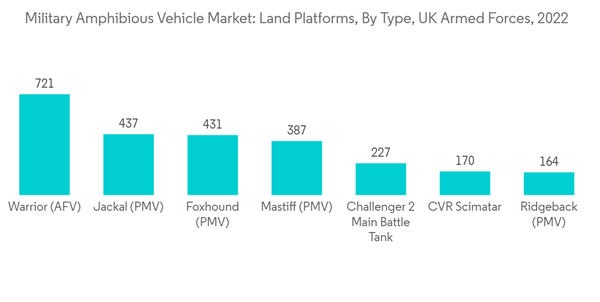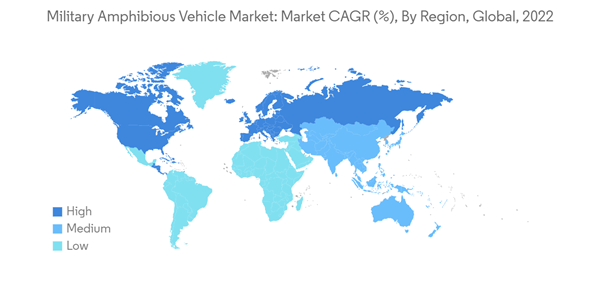The Military Amphibious Vehicle Market size is estimated at USD 2.71 billion in 2024, and is expected to reach USD 3.96 billion by 2029, growing at a CAGR of 7.92% during the forecast period (2024-2029).
The increase in defense budgets, especially in emerging economies, drives the global market for amphibious vehicles. As territorial disputes are increasing all over the world, nations are now focusing on enhancing their military capabilities. An increase in defense expenditures and the rising necessity to perform military search and rescue, assault, and combat support operations in shallow waters are the main drivers for the market studied. The growing global emphasis on securing maritime borders and ensuring coastal defense has fuelled the demand for military amphibious vehicles. These versatile vehicles offer strategic advantages by enabling rapid deployment and maneuverability across both land and water, addressing the evolving security challenges in coastal regions.
Ongoing advancements in technology, including amphibious vehicle design, propulsion systems, and materials, are driving the growth of the market studied. Innovations such as enhanced amphibious capabilities, improved speed, and increased payload capacities contribute to the modernization of military fleets, fostering the adoption of these vehicles by defense forces worldwide. Many armed forces worldwide are undertaking modernization programs to enhance their capabilities. As part of these initiatives, there is a growing emphasis on acquiring technologically advanced and versatile equipment, including amphibious vehicles. However, factors such as their limited operability, the requirement of time-to-time maintenance of the amphibious vehicles, the high cost of maintenance, etc., are projected to challenge the growth of the market studied during the forecast period.
For instance, in April 2023, BAE Systems PLC received a USD 400 million contract to deliver an additional 227 BvS10 amphibious all-terrain armored vehicles to Germany. The award is a part of the joint procurement signed by Germany, Sweden, and the United Kingdom in 2022 to seek a collaborative all-terrain vehicle to support Arctic operations. The deliveries of AGV are set to begin in 2024 and continue through 2030. The BvS10 and its unarmored “Beowulf” AGV variants are designed for optimal maneuverability in all terrain, including steep mountain environments, snow, sand, and swamps. Their NATO-standard amphibious capability is expected to enable forces to operate across coastal waters and flooded fields. Such developments are anticipated to drive the growth of the market studied in the coming years.
The United States is investing huge amounts in the development of advanced land-based vehicles. In this regard, the United States is currently working on its Amphibious Combat Vehicle (ACV) intended to replace the 40-year-old Amphibious Assault Vehicles (AAV) with the Marine Corps. For instance, in March 2023, the US Marine Corps (USMC) awarded BAE Systems PLC a USD 256.8 million contract for additional Amphibious Combat Vehicles (ACVs) under a third order for full-rate production (FRP). BAE Systems PLC also has a contract for two other ACV variants: ACV-R and ACV-30. The ACV Recovery (ACV-R) variant will replace the legacy Assault Amphibious Vehicle Recovery variant (AAVR7A1) and will provide direct field support, maintenance, and recovery. The ACV-30 variant mounts a stabilized, medium-caliber remote turret system that provides the lethality and protection the marines need while leaving ample room for troop capacity and payload. The US Marine Corps approved full-rate production on the ACV-P vehicle in 2021, and the ACV is currently being fielded to Marine Corps Fleet Marine Force units. Such programs are expected to help the growth of the market studied in North America during the forecast period.
Most of the programs in the industry are long-term. Hence, several large-scale contracts are currently underway to develop and produce advanced amphibious vehicle variants as per end-user specifications. Gaining such contracts will help the players in terms of continuous cash-inflow, thereby helping their sustained growth during the forecast period. For instance, in September 2022, WFEL signed a contract with the Irish Defence Forces for the supply of the MGB Medium Girder Bridging System. The MGB variant will be supplied complete with handrails, making the system adaptable for military operations as well as disaster relief and emergency scenarios, such as the recent severe flooding situations seen in Europe.
This product will be delivered within 2 business days.
The increase in defense budgets, especially in emerging economies, drives the global market for amphibious vehicles. As territorial disputes are increasing all over the world, nations are now focusing on enhancing their military capabilities. An increase in defense expenditures and the rising necessity to perform military search and rescue, assault, and combat support operations in shallow waters are the main drivers for the market studied. The growing global emphasis on securing maritime borders and ensuring coastal defense has fuelled the demand for military amphibious vehicles. These versatile vehicles offer strategic advantages by enabling rapid deployment and maneuverability across both land and water, addressing the evolving security challenges in coastal regions.
Ongoing advancements in technology, including amphibious vehicle design, propulsion systems, and materials, are driving the growth of the market studied. Innovations such as enhanced amphibious capabilities, improved speed, and increased payload capacities contribute to the modernization of military fleets, fostering the adoption of these vehicles by defense forces worldwide. Many armed forces worldwide are undertaking modernization programs to enhance their capabilities. As part of these initiatives, there is a growing emphasis on acquiring technologically advanced and versatile equipment, including amphibious vehicles. However, factors such as their limited operability, the requirement of time-to-time maintenance of the amphibious vehicles, the high cost of maintenance, etc., are projected to challenge the growth of the market studied during the forecast period.
Military Amphibious Vehicle Market Trends
The Amphibious Armored Vehicles Segment Dominates the Market During the Forecast Period
Due to its multifaceted capabilities, the amphibious armored vehicles segment is poised to dominate the market. These vehicles are equipped with advanced armor, enabling them to withstand various threats, both on land and in aquatic environments. Their ability to seamlessly transition between different terrains, coupled with advanced weapon systems, positions them as crucial assets for modern military operations. Furthermore, the integration of cutting-edge communication and surveillance technologies enhances the effectiveness of these vehicles in dynamic combat scenarios, making them indispensable for defense forces globally. Amphibious armored vehicles are equipped with specialized features for amphibious assault operations. Their design allows for efficient troop transport from naval vessels to the shore, enabling amphibious landings in contested areas. The integration of advanced assault capabilities, including firepower and troop-carrying capacity, contributes to the sustained growth of this segment.For instance, in April 2023, BAE Systems PLC received a USD 400 million contract to deliver an additional 227 BvS10 amphibious all-terrain armored vehicles to Germany. The award is a part of the joint procurement signed by Germany, Sweden, and the United Kingdom in 2022 to seek a collaborative all-terrain vehicle to support Arctic operations. The deliveries of AGV are set to begin in 2024 and continue through 2030. The BvS10 and its unarmored “Beowulf” AGV variants are designed for optimal maneuverability in all terrain, including steep mountain environments, snow, sand, and swamps. Their NATO-standard amphibious capability is expected to enable forces to operate across coastal waters and flooded fields. Such developments are anticipated to drive the growth of the market studied in the coming years.
North America Expected to Witness Highest Growth During the Forecast Period
North America is anticipated to experience the highest growth in the military amphibious vehicle market. This growth can be attributed to increased defense budgets, geopolitical tensions, and the need for rapid response capabilities in the region. The United States is expected to invest significantly in modernizing its military amphibious capabilities to address evolving threats. The presence of key market players, coupled with ongoing research and development activities, further positions North America as a focal point for the expansion of the military amphibious vehicle market.The United States is investing huge amounts in the development of advanced land-based vehicles. In this regard, the United States is currently working on its Amphibious Combat Vehicle (ACV) intended to replace the 40-year-old Amphibious Assault Vehicles (AAV) with the Marine Corps. For instance, in March 2023, the US Marine Corps (USMC) awarded BAE Systems PLC a USD 256.8 million contract for additional Amphibious Combat Vehicles (ACVs) under a third order for full-rate production (FRP). BAE Systems PLC also has a contract for two other ACV variants: ACV-R and ACV-30. The ACV Recovery (ACV-R) variant will replace the legacy Assault Amphibious Vehicle Recovery variant (AAVR7A1) and will provide direct field support, maintenance, and recovery. The ACV-30 variant mounts a stabilized, medium-caliber remote turret system that provides the lethality and protection the marines need while leaving ample room for troop capacity and payload. The US Marine Corps approved full-rate production on the ACV-P vehicle in 2021, and the ACV is currently being fielded to Marine Corps Fleet Marine Force units. Such programs are expected to help the growth of the market studied in North America during the forecast period.
Military Amphibious Vehicle Industry Overview
The military amphibious vehicle market is consolidated in nature due to the presence of a few players holding significant shares in the market. Some of the prominent players in the market are BAE Systems PLC, General Dynamics Corporation, Lockheed Martin Corporation, Textron Inc., and Rheinmetall AG. As several nations are planning to develop next-generation amphibious vehicles for their militaries, players are looking to grab such opportunities through technological innovations driven by continuous R&D. The market also witnesses a substantial presence of regional players catering to specific geographical demands. Factors such as product performance, reliability, and cost-effectiveness play pivotal roles in shaping the competitive dynamics of the military amphibious vehicle market. Continuous research and development initiatives, coupled with a focus on meeting evolving defense requirements, are key strategies employed by market players to strengthen their positions in this dynamic landscape.Most of the programs in the industry are long-term. Hence, several large-scale contracts are currently underway to develop and produce advanced amphibious vehicle variants as per end-user specifications. Gaining such contracts will help the players in terms of continuous cash-inflow, thereby helping their sustained growth during the forecast period. For instance, in September 2022, WFEL signed a contract with the Irish Defence Forces for the supply of the MGB Medium Girder Bridging System. The MGB variant will be supplied complete with handrails, making the system adaptable for military operations as well as disaster relief and emergency scenarios, such as the recent severe flooding situations seen in Europe.
Additional Benefits:
- The market estimate (ME) sheet in Excel format
- 3 months of analyst support
This product will be delivered within 2 business days.
Table of Contents
1 INTRODUCTION
4 MARKET DYNAMICS
5 MARKET SEGMENTATION
6 COMPETITIVE LANDSCAPE
Methodology

LOADING...










